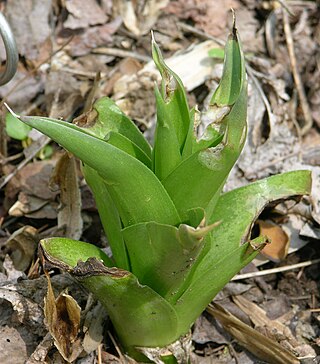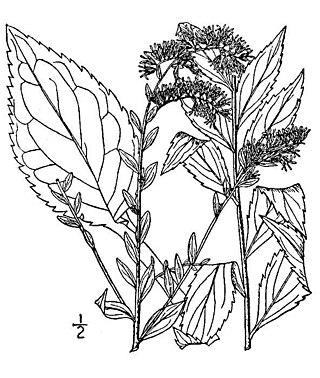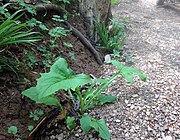
Helianthus is a genus comprising about 70 species of annual and perennial flowering plants in the daisy family Asteraceae commonly known as sunflowers. Except for three South American species, the species of Helianthus are native to North America and Central America. The best-known species is the common sunflower. This and other species, notably Jerusalem artichoke, are cultivated in temperate regions and some tropical regions, as food crops for humans, cattle, and poultry, and as ornamental plants. The species H. annuus typically grows during the summer and into early fall, with the peak growth season being mid-summer.

Tiarella cordifolia, the heart-leaved foamflower, is a species of flowering plant in the family Saxifragaceae. The specific name cordifolia means "with heart-shaped leaves", a characteristic shared by all taxa of Tiarella in eastern North America. It is also referred to as Allegheny foamflower, false miterwort, and coolwort.

Tiarella, the foamflowers, is a genus of flowering plants in the family Saxifragaceae. The generic name Tiarella means "little turban", which suggests the shape of the seed capsules. Worldwide there are seven species, one each in eastern Asia and western North America, plus five species in eastern North America. As of October 2022, the taxonomy of Tiarella in eastern North America is in flux.

Nabalus albus, the white rattlesnake-root, also known as Boott's rattlesnake-root or white lettuce, is a plant in the family Asteraceae, native to Canada and the Eastern United States. Details of the flower heads are needed to separate this species from others in the rattlesnake-root genus (Nabalus). The Iroquois applied a poultice of the roots of white rattlesnake root to rattlesnake bites. It can be found growing in forests, woodlands, and anthropogenic habitats. The flower head has ray flowers only, meaning all of the individual flowers of the flower head have a strap-shaped ray, which may or may not have teeth at the very tip of the ray. The colors vary from blue to purple, pink to red, or white. The leaf blade length can be between 40 and 300 mm. while the flower head width can be 3 to 5 mm. Blooms from July to September in Missouri. In 2010 it was reclassified from the genus Prenanthes to Nabalus.

Trillium cuneatum, the little sweet betsy, also known as whip-poor-will flower, large toadshade, purple toadshade, and bloody butcher, is a species of flowering plant in the family Melanthiaceae. It is a member of the Trillium cuneatum complex, a subgroup of the sessile-flowered trilliums. It is native to the southeastern United States but is especially common in a region that extends from southern Kentucky through central Tennessee to northern Alabama. In its native habitat, this perennial plant flowers from early March to late April. It is the largest of the eastern sessile-flowered trilliums.

Solidago juncea, the early goldenrod, plume golden-rod, or yellow top, is a North American species of herbaceous perennial plants of the family Asteraceae native to eastern and central Canada and eastern and central United States. It grows from Nova Scotia west to Manitoba and Minnesota south as far as northern Georgia and northern Arkansas, with a few isolated populations in Louisiana and Oklahoma.

Nabalus is a genus of Asian and North American flowering plants in the tribe Cichorieae within the family Asteraceae.

Agave virginica, synonym Manfreda virginica, commonly known as the false aloe, rattlesnake master, American aloe, Virginia agave, and eastern agave, is a species of agave. It is native to the central and southeastern United States and northeastern Mexico, where it is found in prairies, upland rocky glades, and sandy open woods.

Vaccinium pallidum is a species of flowering plant in the heath family known by the common names hillside blueberry, Blue Ridge blueberry, late lowbush blueberry, and early lowbush blueberry. It is native to central Canada (Ontario) and the central and eastern United States plus the Ozarks of Missouri, Arkansas, southeastern Kansas and eastern Oklahoma.

Yucca flaccida, commonly called Adam's needle or weak-leaf yucca, is a species of flowering plant in the asparagus family (Asparagaceae). It is native to south-central and southeastern North America, from the lower Great Plains eastward to the Atlantic seaboard in Virginia, south through Florida and the Gulf states. Its natural habitat is in sandy open woodlands and fields. It is not considered to be threatened by the IUCN.

Nabalus barbatus, the barbed rattlesnakeroot, is a plant in the family Asteraceae. It is native to the Southeastern United States where it is found in small numbers in a few disjunct areas of remaining natural grassland. Because of this, it is considered a globally rare species, with only 35-70 remaining populations. Much of its natural habitat of prairie and savanna has been destroyed. In 2010 it was reclassified from the genus Prenanthes to Nabalus.

Chromolaena ivifolia called ivy-leaf false thoroughwort, or ivyleaf thoroughwort, is a species of flowering shrub in the family Asteraceae. It is native to North America and South America, from the south-eastern United States to Argentina.

Solidago ulmifolia, commonly known as elmleaf goldenrod, is a North American species of goldenrod in the family Asteraceae. It is found in Canada and the eastern and central United States.

Rubus cuneifolius, the sand blackberry, is a North American species of flowering plant in the rose family. It occurs in the eastern United States in every coastal state from Louisiana to New Hampshire, with the exception of Rhode Island. There are also reports of inland populations in Tennessee, Arkansas, and Oklahoma, and the species has become an invasive species in South Africa.

Calamovilfa arcuata, commonly known as Cumberland sandreed, is a species of flowering plant in the grass family. It is native to the southeastern United States, where it is found in river scour zones. Due to its specialized habitat, it has a highly localized range, found only on the Cumberland Plateau and in the Ouachita Mountains.

Verbesina helianthoides, commonly called yellow crownbeard or gravelweed, is a species of flowering plant in the family Asteraceae. It is native to the United States, where it is primarily found in the Upper South and South Central areas. Its natural habitat is in communities that receive ample sunlight, such as open woodlands, prairies, and glades.

Hedeoma reverchonii, commonly called Reverchon's false pennyroyal, is a species of flowering plant in the mint family (Lamiaceae). It is native to the south central region of the United States, where it is primarily found in Texas, extending into small areas of Arkansas and Oklahoma. Its natural habitat is on open, calcareous rock outcrops.

Nabalus altissimus, commonly called the tall rattlesnakeroot or white lettuce, is a species of plant in the family Asteraceae. In 2010 it was reclassified from the genus Prenanthes to Nabalus.
Nabalus asper, commonly called the rough rattlesnakeroot or rough white lettuce, is a species of plant in the family Asteraceae occurring in the eastern United States from South Dakota and Pennsylvania south to Oklahoma, Louisiana, and Alabama. This perennial plant blooms in late summer and autumn. In 2010, it was reclassified from the genus Prenanthes to Nabalus.

Hypericum lobocarpum, commonly called fivelobe St. Johnswort, is a species of flowering plant in the St. Johnswort family (Hypericaceae). It is native eastern to North America, where it is found primarily in the western portion of the southeastern United States. Its typical natural habitat is in open wet areas, such as stream banks, lake margins, swamps, and pine savannas.





















